Traditional costumes, Dala painting, Dala horses, and much more.
Already in the entrance hall, you are greeted by the diversity that Dalarna offers. The bustling street life of Falun outside the window contrasts sharply with the tapestry depicting the moss-covered river of Fulufjället in northern Dalarna. Explore the museum and enjoy the art, from prints to paintings by beloved Dalarna artists. Immerse yourself in front of Hagström’s gleaming electric guitars. Admire the extensive collection of our most famous souvenir – the Dala horse. Step into the world of Dalarna painters and feel the wings of history among colorful parish costumes or in Selma Lagerlöf’s library. – The experiences are many.
In addition to the museum’s permanent exhibitions, we display a number of temporary exhibitions each year.
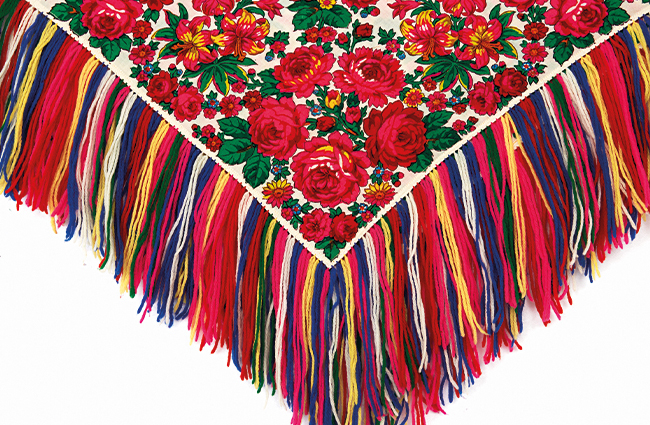
Dressed in Dalarna
The people of Dalarna’s clothes for everyday and festive occasions
Dalarna Museum’s new Costume and Textile Exhibition
Our region perhaps has the country’s most extensive, well-known, and still often used costumes. Usually, it is, of course, the fancy clothes that are preserved, and they tell not only of revelry and a golden edge to the often tough everyday life. They also tell of strict social control where the length of a skirt was as important as the boundaries of the potato field and where married women tucked hair strands under their bonnets with knitting needles. The idea of a veil to hide female charms is not an imported phenomenon in Sweden.
Carefully sewn clothes lasted longer, and what became worn out was then used for everyday wear. A shift that ended up in a showcase has over 50 patches, but still holds together.
A selection of all the approximately 50 parish costumes that are in the museum’s storage is shown, while we also highlight details, materials, and manufacturing methods in various displays.”
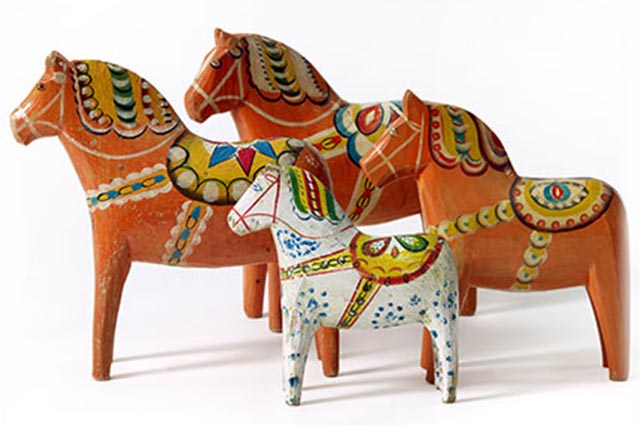
Dala horses a symbol of Sweden
Everyone loves the Dala horse.
At the World’s fair in New York in 1939, a very large red decorated Dala horse was placed in front of the entrance to the Swedish pavilion, thus elevating a regional souvenir to a national symbol!
Dalarna Museum probably has the world’s largest collection of Dala horses, in all their forms. In this exhibition, we show a large and varied selection of them, from the oldest to today’s free interpretations of the Dala horse phenomenon.”
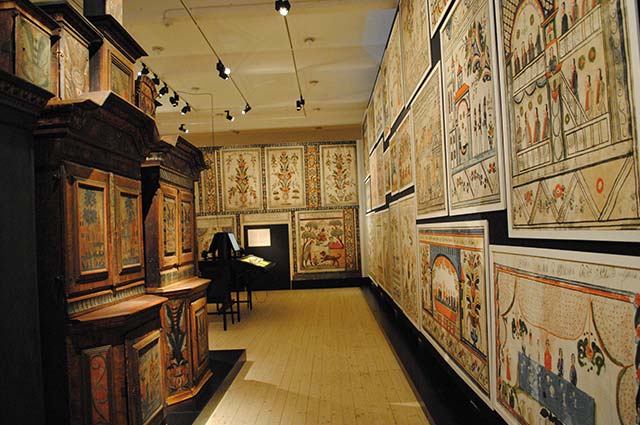
Dala painting
A parish craft
Dala painting refers to a folk decorative painting that first appeared on furniture but later moved onto the walls of wealthy farmers’ homes.
Dala painting is perhaps one of the most unique aspects of Swedish folk art and reached its peak around the turn of the 19th century.
In this exhibition, the background is explained, from where the painters drew their inspiration, and how they created their works. But above all, a rich selection of original paintings from the museum’s extensive collection of Dala paintings is displayed, along with embellished furniture.
A Dala painter’s workshop with all its paraphernalia and a completely painted and furnished room interior are available for admiration and contemplation.
In a smaller room, we can then explore the contemporary use of Dala painting/kurbits in more commercial contexts.
The similarities with today’s popular culture are more than one might initially think. Fashion magazines often served as sources of inspiration for the painters, and silhouettes and attire are sometimes taken directly from magazine pages. Using stencils was common to avoid reinventing the wheel each time. Men are men, and women are women unless they are put through the age mill – for then they become young maidens again.

The City and the World Heritage
The mine side and the fine side
Industrial activities have had a significant impact on the Dalarna landscape. The copper mine dominated Falun and shaped the city’s history and appearance. Many other industries have also flourished in the region.
In this exhibition, parts of Dalarna’s industrial heritage and some of the people who lived here are presented.
Aunt Karlström welcomes us into her simple, little miner’s cottage, and around the corner, we can peek into a mine owner´s elegant salon.
A film room might tempt you to sit down for a while to enjoy new and old industrial films.
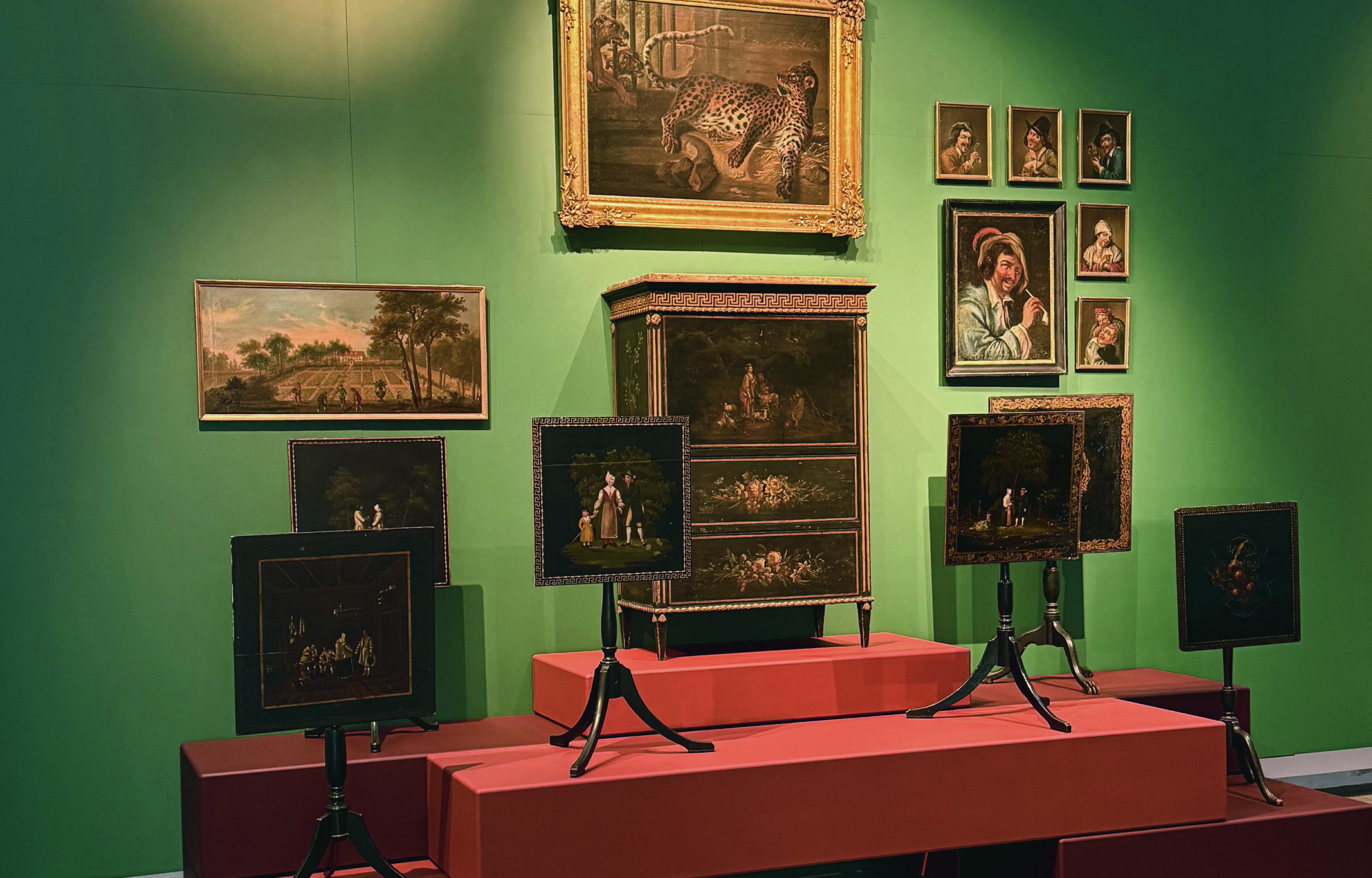
Art, Crafts, and Design in Dalarna
from the 17th Century to Today
Discover the hidden treasures of Dalarna’s history!
June 28-2025, Dalarna Museum opens the doors to an entirely new and exciting permanent exhibition—filled with unique objects that have never or rarely been shown to the public. In the first phase, you can step into a world of exclusive craftsmanship: admire magnificent porphyry pieces from Älvdalen, hand-painted furniture with rich histories, and artworks that capture both soul and style—from tradition to contemporary culture.
This is just the beginning—the exhibition will expand in multiple stages.

Legendarium – The Language of Fantasy
From november 2024 to autum 2025
A temporary exhibition with the theme of myths, magic, and fantasy!
The real world is full of tales, spells, and monsters—many of which have found their way into fantasy films and games.
What does The Elder Scrolls™ have to do with Saint George and the Dragon?
And is there a connection between The Witcher™ and medieval Dalarna?
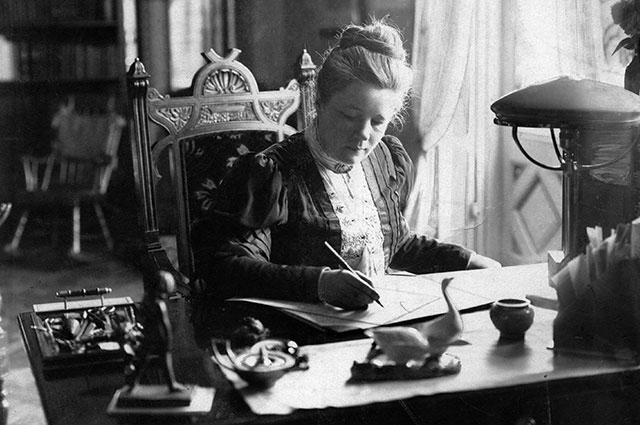
Selma Lagerlöf
Welcome to Selma Lagerlöf’s home in Falun.
The veranda door stands wide open, and the hall’s paneling is freshly painted. The dim library is intact, from the heaviest book to the finest paperweight. The room invites tiptoed caution; it feels like you’re disturbing someone’s peace as you step over the threshold. Here, she wrote her great stories.
But outside the library, another Selma is present. The Selma who loved theater and had her own chair in the old theater in Falun. The Selma who indulged in clothes and shoes, ordered hats, and pondered over daily style combinations. The Selma who shrank from social gatherings and often felt out of place in the finer cultural circles. The Selma who was grandly celebrated on her 50th birthday by the schoolchildren of Falun and was made happy by it.
Selma Lagerlöf achieved success as an author in Sweden and abroad during her years in Falun, but she reserved a place in her heart for the rough and outcast. She felt most at home on the mine side of the city, which was barren and treeless, lying in the shadow of the mine. And she had a noticeable fondness for Tisken. The polluted little lake where all the dirt from the stream Falu ån settled and where not even the waterbirds would take their morning dip.
’…I have such a wonderfully warm and quiet study in my villa that it’s a help in my work.’
Selma Lagerlöf lived in Falun from 1897. The villa she bought in 1907 and owned until her death in 1940, located at Villavägen 34-36, is now demolished, but her library and study from there were reconstructed in 1985 in a part of the extension to the Dalarna Museum, which was then completed.

Hagström
Hagström 4ever
Welcome to Hagström 4ever – an exhibition designed to allure and tempt. We aim to tantalize your senses by highlighting moments from Hagström’s extensive production history, from the Excellent accordion to artists playing Hagström instruments today.
In this exhibition, you will experience glittering and gleaming treasures in the form of musical instruments, amplifiers, and other exciting materials. We have selected a number of jewels from Hagström’s treasure trove that will surely leave you with a desire to learn more and deepen your knowledge about AB Albin Hagström’s impact on Swedish music life. In addition to the items on display, you can also see and experience Hagström ambassador Clas Yngström playing and talking about guitars and amplifiers in a specially produced film.



